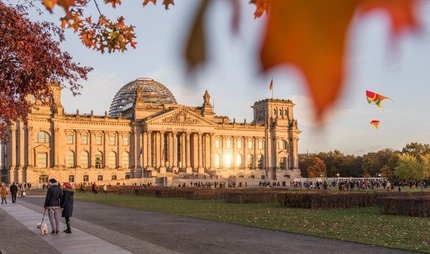
Deutscher Dom
Milestones, setbacks and sidetracks in German history
A place steeped in history: the Deutscher Dom graces Gendarmenmarkt. But you ought to visit the exhibition inside – it’s definitely worth it.
Gendarmenmarkt in Mitte is an impressive square where two imposingly domed buildings called the Französischer Dom and the Deutscher Dom frame the rightly admired Konzerthaus.
Like its counterpart the Französischer Dom, the Deutscher Dom takes its name from the domed structure on top of it. Despite what many assume, it is not a church (“Dom” is the German word for a cathedral).
History of the Deutscher Dom
When it was first built at the beginning of the 18th century it actually was a church. Later, under Friedrich II, Carl von Gontard embellished the two churches with magnificent Baroque domes, purely for bombastic decoration.
After the March Revolution of 1848, the revolutionaries laid out their fallen comrades on the steps of the Deutscher Dom and many Berliners attended a church service to take their leave of them at Gendarmenmarkt. The scene was depicted by the Berlin artist Adolph Menzel in his painting The Laying-Out of the Fallen March Revolutionaries.
Destroyed in 1943 by a fire, the Deutscher Dom lay in ruins for a long time, and was only rebuilt in stages between 1982 and 1996
The exhibition Milestones – Sidetracks – Setbacks
Today the Deutscher Dom houses the Bundestag’s exhibition Milestones – Sidetracks – Setbacks. In an interactive and entertaining way, the exhibition on five floors presents the changing history of the parliamentary system from the March Revolution of 1848 to the present day. The exhibition used to be in the Reichstag and was part of the programme for every school trip from West Germany to Berlin.
The exhibition gives you an overview of the development and the work of the political parties in Germany. Photos, installations and films illustrate parliament’s turbulent history: the first National Assembly in 1848, development during the German Empire, the destruction of democratic systems by the Nazis, and the new beginning in the post-war years.
Information for schools
The Deutscher Dom offers free guided tours for groups and school classes, but they must be booked in advance on 030 227-30431 or 030 227-30432. On request and registration, it also offers educational projects for pupils and slide shows for secondary schools on various subjects.
In the role-play Plenary Session, young people and adults can take the part of members of parliament and participate in a parliamentary meeting.
| Oct - Apr | Tue - Sun | 10am - 6pm |
| May - Sep | Tue - Sun | 10am - 7pm |



